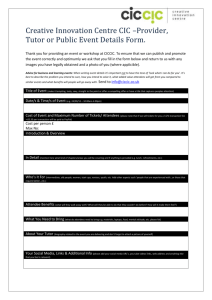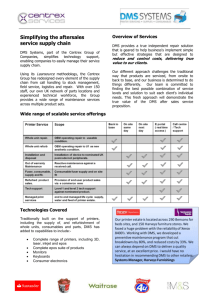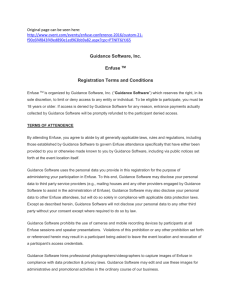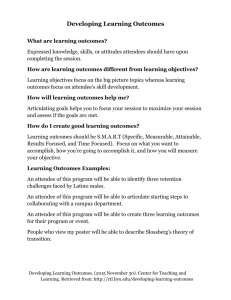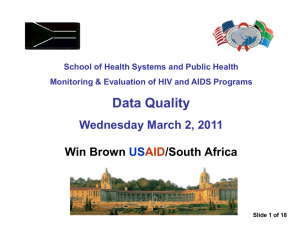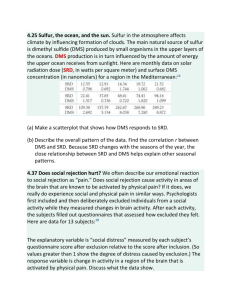FinalVisionDocument... - The University of Texas at Dallas
advertisement
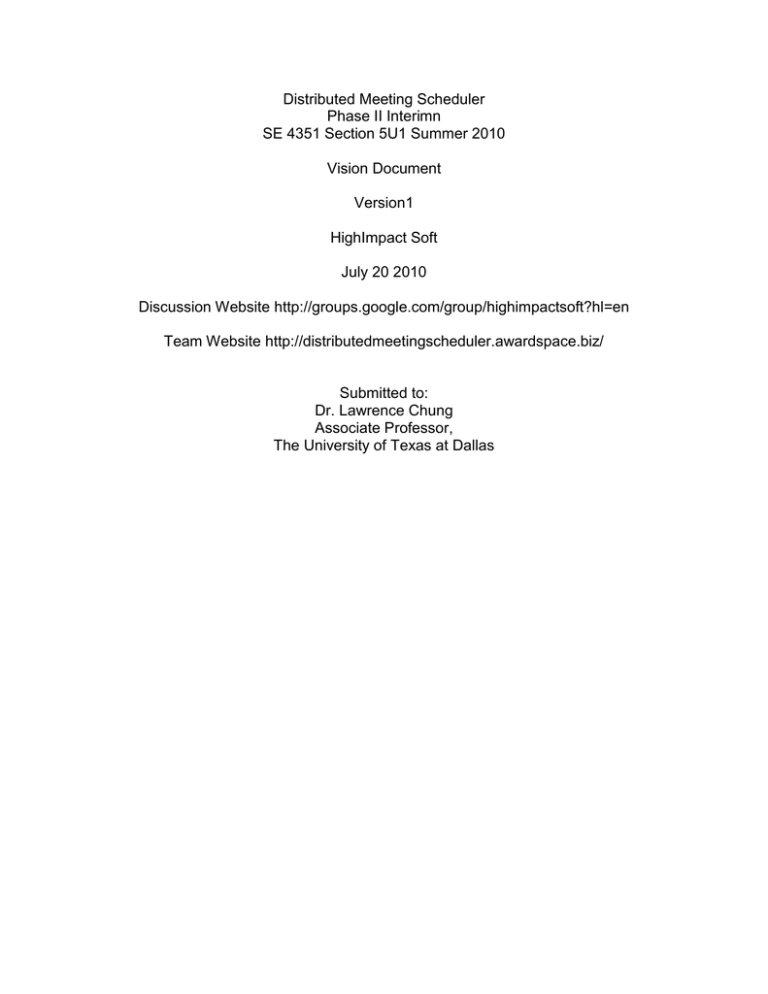
Distributed Meeting Scheduler Phase II Interimn SE 4351 Section 5U1 Summer 2010 Vision Document Version1 HighImpact Soft July 20 2010 Discussion Website http://groups.google.com/group/highimpactsoft?hl=en Team Website http://distributedmeetingscheduler.awardspace.biz/ Submitted to: Dr. Lawrence Chung Associate Professor, The University of Texas at Dallas Revision History Version 1.0 1.1 Author(s) Sergio Loza Sergio Loza Update Initial Document Class Diagram, Fishbone diagram, Use case Diagram i Date Completed July 20, 2010 July 27,2010 Table of Contents Revision History………………………………………………………………………….....i Table of Contents…………………………………………………………………………..ii 1.Introduction..............................................................................................................1 1.1Purpose....................................................................................................................1 1.2Scope.......................................................................................................................1 1.3 Definitions, Acronyms, and Abbreviations...............................................................2 1.4References...............................................................................................................4 1.5 Project Overview.....................................................................................................5 2. Positioning.................................................................................................................5 2.1 Business Opportunity.................................................................................................5 2.2 Problem Statement....................................................................................................6 2.3 Product Position Statement.......................................................................................7 3. Stakeholder and User Descriptions.........................................................................8 3.1 Market Demographics................................................................................................8 3.2 Stakeholder Summary...............................................................................................9 3.3 User Summary..........................................................................................................11 3.4 User Environment.....................................................................................................12 3.5 Key Stakeholder Profiles.........................................................................................13 3.5.1 Meeting Coordinator..............................................................................................13 3.5.2 Meeting Attendee.................................................................................................14 3.6 Key Stakeholder or User Needs...............................................................................15 3.7 Design Class Diagram..............................................................................................17 3.8 Alternatives and Competition....................................................................................18 4. Product Overview...................................................................................................19 4.1 Product Perspective.................................................................................................19 4.2 Summary of Capabilities..........................................................................................19 4.3 Assumptions and Dependencies..............................................................................19 4.4 Cost and Pricing......................................................................................................19 4.5 Licensing and Installation.........................................................................................20 5. Product Features.....................................................................................................20 6. Constraints...............................................................................................................21 6.1 Security..................................................................................................................21 6.2 Usability.................................................................................................................21 6.3 Responsiveness.....................................................................................................21 6.4 Capacity.................................................................................................................21 6.5 Reusability...............................................................................................................22 7. Quality Ranges.........................................................................................................22 8. Precedence and Priority.........................................................................................22 9. Other Product Requirements.................................................................................22 9.1 Applicable Standards..............................................................................................22 9.2 System Requirements.............................................................................................22 9.3 Performance Requirements....................................................................................22 9.4 Environmental Requirements..............................................................................23 10. Documentation Requirements............................................................................23 10.1 User Manual.........................................................................................................23 ii 10.2Installation Guides, Configuration, and Read Me File........................................23 10.3 Labeling and Packaging...................................................................................24 11 Why our product is better……………………………………………………………25 iii 1. Introduction 1.1 Purpose The purpose of the DMS is to automate the process of scheduling a meeting while considering time constraints of all the participants. The system will enable users to initiate and schedule meetings while viewing times that potential meeting attendees are busy. Through this automated process, meetings will be scheduled with a great deal more efficiency than the prior method of selecting and scheduling meeting times which required multiple communications between meeting initiator and participants before a time could be selected. 1.2 Project Scope The project Distributed Meeting Scheduler automates the process of scheduling meetings. It is a type of resource allocation and collaboration system. The main function of this project is to schedule meetings based on the availability of resources and constraints put forward by the resources. There are primarily two actors in the system: 1. Meeting Initiator Responsible for initiating a meeting and defining an interval within which a meeting can be held. 2. Potential Meeting Attendees These people will be attending a meeting and will provide availability timings and non-availability timings to the system. Some meeting attendees can be further classified into three categories: a) Important Participants: [3] 1 Meeting attendees who may specify their preferred meeting locations b) Active Participants: [3] Meeting attendees who may be providing special equipment requirements for the meeting like projector, internet connection etc. c) Regular Participants: Meeting attendees who specify their preferred and exclusion sets only The system functions in the following manner: 1. The meeting initiator initiates a meeting along with the day interval within which the meeting can take place 2. The meeting attendees provide their exclusion set. 3. The system then finds a feasible meeting time along with an available room. 4. If there are any conflicts, the system supports conflict resolution using the conflict policy provided by the client 5. The system also supports changing user constraints at any time, implied that such time is before the meeting takes place. 1.3 Definitions, acronyms, and abbreviations Meeting: scheduled gathering of two or more people. Meeting parameters include: date, time, initiator, participants, place (physical or virtual) Meeting initiator: A person who initiates a meeting, notifies possible participants, determines potential meeting dates/times/places; may also be a participant. Potential attendee: A person who provides a set of dates when they may or may not be able to attend a proposed meeting. Participant: A person who attends a meeting. 2 Exclusion set: set of dates provided by potential attendees when they cannot attend a proposed meeting. Preference set: set of dates provided by potential attendees when they can attend a proposed meeting. FT- Forward Traceability BT- Backwards Traceability FR- Functional requirement NFR- Nonfunctional requirement DR- Domain Requirement IFR- Improved Functional requirement INFR- Improved Nonfunctional requirement Active participant- A meeting attendee who will do a presentation Important participant: A meeting attendee who must be in the meeting Regular participant: A meeting attendee who is not an active or important participant OO: Object-Oriented GUI: Graphical User Interface SE: Systems Engineering SRS: Software Requirements Specification 3 1.4 References Lawrence Chung, Requirements Engineering syllabus, CS 4351 section 5U1, Summer 2010. http://www.utdallas.edu/~chung/CS4351 Bernd Bruegge, Allen H. Dutoit, Object-Oriented Software Engineering Using UML, Patterns, and Java, second edition. Prentice Hall, 2003. http://wwwbruegge.in.tum.de/OOSE/ http://www.utdallas.edu/~nml061000 Team Steelers HTTP://UTDALLAS.EDU/~SRW 051000/SE6361_BLITZKREIG/ TEAM BLITZKREIG http://re-project.org/default.aspxc TEAM: EKLAVYA L. Chung, B. Nixon, E. Yu, and J. Mylopoulos, Non-Functional Requirements in Software Engineering. Kluwer Academic Publishing, 2000. Team Awesome http://www.utdallas.edu/~rhb081000/6361/ Project Phase I: Requirements Elicitation: Initial Understanding: http://www.utdallas.edu/~chung/RE/Project1.pdf Project Phase II: Requirements Elicitation, Specification, and Validation: http://www.utdallas.edu/~chung/RE/Project2.pdf A Template for WRS Evolution: http://www.utdallas.edu/~chung/RE/WRStemplate.rtf US Census Data, 2004, http://www.census.gov/epcd/www/smallbus.html Prototype developed by Scott Willock 4 1.5 Project Overview For any organization to function efficiently, personnel must be able schedule meetings without wasting vast amounts of time determining a time and location to fit everyone's schedule. This is a project plan describing the Distributed Meeting Scheduler (DMS), a program that will assist in automating the process of determining the best times for various participants to meet. The project involves creating a scheduler which will allow users to initiate meetings and acquire information about potential meeting attendees' time preferences to find an optimal meeting time. DMS users will update their schedules with times they are unavailable to help guide users who are initiating a meeting to find the best available meeting time. 2. Positioning 2.1 Business Opportunity Communicating between different individuals and professionals has become a big issue on today's world. The difficulty has risen in trying to schedule meetings between different people because of hectic schedules, busy lives and different work schedules. This is a perfect opportunity to create an easy to use scheduling system that allows people to schedule meeting and resolve conflicts in an efficient visual interface. 5 2.2 Problem Statement The problem of Not being able to schedule meetings between participants due to conflicting schedules affects The people need to be involved in the meeting The impact of which is A lack of communication between supposed meeting participants which leads to poor due to the inability to create a meeting A successful solution would be a web based l interface that allows participants to resolved their. The system would allow the participants involved in the meetings to modify their meeting preferences to satisfy and resolve an appropiate meeting time by using the web based interface. In addition, the people involved in the meeting can opt to be a virtual participant, thus resolving any conflicts by being present from a virtual location. 6 Fishbone diagram 7 2.3 Product Position Statement For Professionals and Individuals Who are in need of resolving conflicting The Distributed meeting Scheduler meetings between involved participants. Is a software product hosted on a web server That Will aid the meeting participant in resolving any conflicting meeting in visual interface that will show the potential meeting times among the selected participants Unlike Conventional meeting schedulers that only show the conflicting times without giving the user a potential time for a meeting Our product Presents data to the user depending on the status of each participant, thus allowing the user to select the best potential time depending upon the type of meeting that the user is intenting to have 8 3 Stakeholders and User Descriptions 3.1 Market Demographics The target market is mid-size companies with multiple offices/locations across the United States. As the number of employees increases, the difficulty of coordinating meetings grows. And, as the number of locations grows due to branch offices or telecommuting employees, the need for a distributed meeting scheduler system becomes increasingly importance. Since businesses with less than 20 employees can usually operate in an adhoc manner with little difficulty, a meeting scheduling system would not be critical. Since larger organizations are more likely to have a system in place and to rely on existing vendor relationships, this segment is better targeted once the software has achieved maturity. The small to mid-size company is the segment most likely to benefit from a distributed meeting scheduler system with the current feature set under development. The table below highlights the target market of 20 to 1000 employees which includes over 600,000 US businesses. Business Size (Based on # Employees) 1 to 4 employees 5 to 9 employees 10 to 19 employees 20 to 99 employees 100 to 499 employees 500 to 749 employees 750 to 999 employees 1,000 to 1,499 employees 1,500 to 2,499 employees 2,500 to 4,999 employees 5,000 to 9,999 employees 10,000 employees or more TOTAL Target Market, 20 to 1000 employees: # Firms 2,777,680 1,043,448 632,682 526,355 86,538 5,695 2,709 2,828 2,281 1,739 905 890 5,083,750 621,297 # Establishments 2,782,252 1,055,937 666,574 692,677 330,447 66,305 41,835 57,479 76,491 106,893 120,311 587,168 6,584,369 1,131,264 Avg # Establishments /Firms 1.0 1.0 1.1 1.3 3.8 11.6 15.4 20.3 33.5 61.5 132.9 659.7 1.3 1.8 9 US Census Data, 2004, http://www.census.gov/epcd/www/smallbus.html 3.2 Stakeholders Summary Name Description Responsibilities Highimpact Soft Customer. Works with Pays for development Signs-off on System Analyst and Project artifacts and plans Coordinates manager to define product acceptance testing and oversee rollout System Analyst Works with stakeholders to Leads and coordinates gather needs and wants. requirements elicitation and usecase modeling. Outlines domain, system environment, and software requirements. Software Developer Develops the software Performs high-level design, lowlevel design, and implementation. Ensures design complies with requirements. Project manager Works with the System Monitors the project's progress and Analyst to correctly translate timeline. Implements and oversees requests/needs into the process model. Plans, manages requirements to be used for and allocates resources. Shapes design. priorities and coordinates interaction with non-user stakeholders. Oversees creation, sign-off, and 10 archiving of artifacts. Test Verifies the developed Verifies requirements through test of software the software/system. Writes test cases, tests software, feedback to development and project management. Maintenance Maintains the develop Input/feedback on artifacts to ensure software. the 3.3 User Summary Name Description Responsibilities Stakeholder Meeting Primary End User Initiates and coordinates System Analyst meetings. Prioritizes meeting HighImpact Soft Initiator participants. May operate on behalf of another employee (especially executive). Reschedules meetings when needed. Meeting Attendee Primary End User Uses software to System Analyst communicate availability, HighImpact Sofrt resource needs, and location preferences. 11 IT Management Decision-maker for purchasing Makes software decisions for System Analyst, business. Accountable to the business software business. Assigns and Business Manager manages resources for software support. IT Team Evaluator of Installation of software System Analyst, software, throughout the business. Business influences First-line of support for Manager software users. Administrator of purchasing software. decisions 3.4 User environment The number of users involved in a meeting will vary depending on the purpose of the meeting. The software is intended to make scheduling a meeting an efficient process, however the number of participants, schedules, and conflicts will ultimately dictate the time and complexity involved in scheduling a meeting. The meeting initiator is the primary user who has responsibility for completing the task of scheduling a meeting. Attendees will be entering personal schedules and preferences regularly, thereby limiting their involvement to accepting/declining a meeting invitation. Concerns or issues identified with use of the software will be escalated to the IT Team. A user accesses the software across the internet using browsing software running on either a wireless or wire-line computer or computing device. The browser software must 12 support javascript which includes: Firefox 3.5, Internet Explorer 8.0, Opera 10.10, Google Chrome 4.1.X, and Safari 4. Each user is required to have a valid UserID for access. The software administrator has the responsibility for managing UserIDs and password resets across the organization. Additionally, the user-interface is designed for ease of understanding and navigation. 3.5 Stakeholder Profiles 3.5.1 Meeting initiator Representative None Description A representative (secretary or manager) who uses the system to plan and initiate a meeting based on date, time and availability of resources. Type Expert user who is in management level position and has experience in handling meetings. Responsibilities Ensure that the meetings are planned at the best possible date, time and meeting location and initiated meetings are scheduled with minimum conflicts and with minimal interactions. Success Criteria Success is defined by the meeting initiator satisfaction and ease of continued use of the system and also in the ability to 13 schedule meetings on a preferred date, location and should be simple, conflict resolution quick and with less number of negotiations. Involvement We will have internal members of our project team to help evaluate our design and guide our vision. Deliverables None Comments / Issues None 3.5.2 Meeting Attendee Representative None Description A person who has been invited for a meeting and can accept or reject a meeting invite based on his availability. Type Casual user who has basic experience with web based applications. Responsibilities Ensure that they respond to all meeting invitations and inform the meeting coordinator of their exclusion sets well in advance and confirm attendance. Success Criteria Success is defined by the less number conflicts in meeting arrangements, 14 uninterrupted use of the system and in the ability to accept a meeting request. Involvement We will have internal members of our project team to help evaluate our design and guide our vision. Deliverables None Comments / Issues None 3.6 Key Stakeholder or user needs Need Priority Concerns Current Proposed Solution Solution Ease of High To schedule None Develop Web based scheduling meetings easily Meeting scheduler meetings through a web system based system Resolve High conflicts in date, To resolve the None conflicts Provide efficient conflict resolution technique time and location quickly and efficiently To select High To manage None The meeting coordinator preferred convenient will select the best date meeting location location and date based on preference set 15 and date Accessibility and location High Access to the None Develop a Web based system from any application which can be part of the world accessed on Internet without any special installation Secured access High To manage user None Provide user with userid and meeting and password by information administrator for secured access of information Usability High To develop None Provide user friendly and simple and easy help guided web based to use system by application through the all kinds of users use of a read me file 16 3.7 Design Class Diagram Meeting Date +Type of meeting 1 Proposes Meeting Initiator DMS 1 Has 0..* 1 +User Name +Password 1 1 1 creates sends Mantains 1..* Meeting 1 +Location Preference +Proposed Date +Participants +Equipment Database +Participants information +Meetings History 0..* Has 1..* Notifiation Accepts 1..* +Proposed date +Proposed Location Set +Exclusion Set 1 Receives 0..* Provides 1 Participants 1 1 +User Name +Password 17 3.8 Alternatives and Competition • Microsoft Outlook 2007: Is the most popular and commonly used application for scheduling meetings in many organizations. We can send and receive text and picture messages between Office Outlook 2007 and any mobile phone. It automates timeconsuming calendaring task. • IBM LotusNotes 7: This software is also used by many organizations. Has the capability to process incoming calendar invitations automatically, even when there is a conflict. Be able to personalize the display of calendar invitations based on type (meetings, appointments, remainders, events) or invitee status(confirmed or tentatively accepted) with easy to use calendar filters. • Google Calendar: This is a free web-based calendar used to schedule meetings. Schedules from other applications can be easily imported. • Office Tracker (Milum Corporation): Office Tracker Scheduling Software lets us to create schedules and shared calendars for scheduling group meeting, conference rooms, send automated notifications to all involved, and track resource usage. • Apple iCal: This is a powerful desktop calendar which runs on Mac OS X operating system. It tracks appointments and allows multiple calendar views to quickly identifies conflicts and free time. It is also integrated with MobileMe, so calendars can be shared and synced with PCs, iPhones, iPod touch over the Internet. It allows notification of upcoming events on screen, by email, SMS, or pager. 18 4.Product Overview 4.1 Product Perspective Users will be able to access the Distributed Meeting Scheduler (DMS) using the interface of the simple web browser to initiate meetings 4.2 Summary of Capabilities 1. System is accessed by Internet 2. Meetings are initiated conveniently through clicking on a calendar interface. 3. The meeting scheduling control provides a comprehensive display of when a meeting can take place . 4. Dynamic conflict resolution of date for different meeting attendees 19 4.3 Assumptions and Dependencies • The user's computer meets the minimum hardware and software requirements to run the DMS. • Meeting initiator have the knowledge of who the invitees are • Meeting scheduler system involves all the users of the business organization who are present in the database of the system. • If a user is busy at some time he should add it in the meeting scheduler. 4.4 Cost and Pricing Competing products currently in the market sell for $83.99 to $29.99. Our product is competitive in comparisons to existing product in the market and provide with some additional features. Price : $23.99 4.5 Licensing and Installation Product is very generic and is supplied to customer on a license-basis. No installation support and maintenance of the product would be provided. Installation is very easy and product would be supplied with the user manual which will show the step by step installation procedure and how to use the system. 20 5. Product Features Use case diagram 5.1. Start software The user needs to be able to start up the system remotely. 5.2 Shutdown software The user needs to be able to shutdown the system gracefully remotely. 5.3 View status of system The user needs to be able to view the status of the system gracefully remotely. The following features relate to initiating a meeting: 21 5.4 Click on schedule meeting button to create meeting 5.5 include the subject of the meeting as well as the preferred date and time for the meeting 5.6 Add important participants from available participants 5.7 Add active participants from available participants 5.8 Add regular participants from available participants 5.9 Select meeting location from available locations 5.10 Click on submit button to send the invitation to all selected participants The following features relate to viewing the meeting calendar of the system 5.11 View the list of accepted meeting 5.12 Accept or decline a pending meeting 6. Constraints 6.1 Security The DMS has security measures that are both standard and optional depending on the installation server. Unique user IDs allow access to user-specific portions of the site. No confidential information is stored on the server-side of the DMS. 6.2 Usability The DMS was designed first and foremost to be user friendly, allowing many options and available actions through your home page. The options for creating a meeting are presented in an intuitive manner.. 6.3 Responsiveness Responsiveness of the DMS will be primarily determined by the internet connection and server capabilities. The client will be limited mainly by their internet connection. As with 22 any web based system, intermittent or bad connections can affect performance and responsiveness. The server limitations are much lower, requiring many more users than most medium-sized organizations have before additional additional considerations may be necessary. 23 6.4 Capacity At current configuration, the DMS has a virtually 'unlimited' capacity and could easily handle hundreds to thousands of users and meetings before additional considerations may be necessary. 6.5 Reusability The DMS can be reused (rebranded) to service other institutions. This may include aesthetic redesign, however the core components of the meeting scheduler may remain intact. 7. Quality Ranges None specified. 8. Precedence and Priority The system must be available by July 2010. 9. Other Product Requirements 9.1 Applicable Standards As with any web-based system, certain 'best practice' guidelines are involved to accomodate interoperability, usability and accessibility for users accross the web. The DMS was designed in PHP 5. World Wide Web Consortium (W3C) standards were used, including HTML and XHTML.. 9.2 System Requirements The DMS has low system requirements, needing only an internet connection and web browser that supports javascript. (Tested with Firefox 3.5, Internet Explorer 8.0, Opera 10.10, Google Chrome 4.1.X and Safari 4) 24 The server-side requirements are also minimal, requiring only PHP and an SQL database. 9.3 Performance Requirements The system must promptly react to user actions to create a responsive system. This is achieved by having efficient code and is aided (and limited) by the internet connection of the end user. 9.4 Environmental Requirements The system assumes that the user is familiar with standard web-based navigation and interaction. Additional documentation will be provided to help users unfamiliar with these interactions. Specific computer knowledge or programming experience is unnecessary for the end user. 10. Documentation Requirements 10.1 User Manual The manual is electronic online documentation in text format. This documentation will be contained on a website external to the DMS installation. The text documentation will contain a more formal item-by-item description of each button and feature of the system. 10.2 Installation Guides, Configuration, and Read Me File Administrator help will be provided in the online documentation, including installation and configuration instructions. The Readme will contain basic information on how to access the online documentation. 25 10.3 Labeling and Packaging This product is distributed electronically, rather than through physical media, therefore has no packaging design. 26 11 Why our product is better Our system allows initiators to decide a meeting type depending upon the initial feedback that the DNS gives. An initiator can decide whether all of the important participants have to be there. This allows for the great variety of meetings that take place in the business world such as stakeholder meetings and general meetings. Our system will remind participants of upcoming meetings which is an idea that we have incorporated from Rachel’s team. Furthermore, our system gives the initiator control over the final decision of when a meeting will take place and minimizes the problem of meeting location by accommodating locations on a first come first serve basis. For participants, DMS will only inquire them about their exclusion set and not the preference set or their preferred location. This will minimize the amount of information that a participant will need to enter when accepting an invitation. To make the system more secure, our system is designed to send an invite to a meeting participant only if his/her username or email id is known by the initiator. 27

